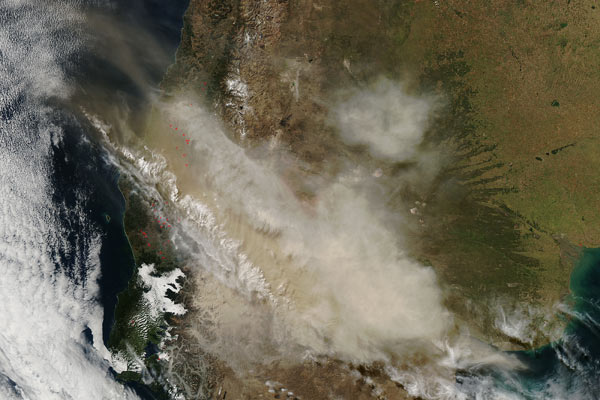Images
May 2, 2015 - Plume from Calbuco volcano, Chile
Tweet
Between April 22 and April 30, 2015, Chile’s Calbuco volcano erupted three times, spreading ash across parts of both Chile and Argentina.
The first eruption began with strong seismic activity, which, within 2 hours of the first tremor resulted in a strong eruption with a large ash plume. Shortly after the eruption, lava began to flow from the caldera, and about 4,400 people were evacuated from areas near the mountain. The small towns of Ensenada, Correntoso and Lago Chapo were reported evacuated, and air traffic was diverted away from the airport at Puerto Montt.
A second strong explosive eruption occurred around 0400 UTC (1:00 pm local time). A large lava fountain, incandescent lava bombs and lightening created by the eruption made for a spectacular display. Ash plumes were reported to rise between 39,400 ft (12 km) to 65,600 ft (20 km), and reports of lava bombs were reported to have been ejected as far as 5 km from the caldera. After several days of relative quiet, another strong eruption occurred on April 30, with ash rising to 16,000 ft (5 km).
This image was captured during the second eruption by the Moderate Resolution Imaging Spectroradiometer (MODIS) aboard NASA’s Aqua satellite on April 23. A think brown plume rises from the caldera and drifts from the caldera of Calbuco over the South Pacific Ocean.
Image Facts
Satellite:
Aqua
Date Acquired: 4/23/2015
Resolutions:
1km (462.7 KB), 500m (1.6 MB), 250m (3.9 MB)
Bands Used: 1,4,3
Image Credit:
Jeff Schmaltz, MODIS Land Rapid Response Team, NASA GSFC
Tweet
Between April 22 and April 30, 2015, Chile’s Calbuco volcano erupted three times, spreading ash across parts of both Chile and Argentina.
The first eruption began with strong seismic activity, which, within 2 hours of the first tremor resulted in a strong eruption with a large ash plume. Shortly after the eruption, lava began to flow from the caldera, and about 4,400 people were evacuated from areas near the mountain. The small towns of Ensenada, Correntoso and Lago Chapo were reported evacuated, and air traffic was diverted away from the airport at Puerto Montt.
A second strong explosive eruption occurred around 0400 UTC (1:00 pm local time). A large lava fountain, incandescent lava bombs and lightening created by the eruption made for a spectacular display. Ash plumes were reported to rise between 39,400 ft (12 km) to 65,600 ft (20 km), and reports of lava bombs were reported to have been ejected as far as 5 km from the caldera. After several days of relative quiet, another strong eruption occurred on April 30, with ash rising to 16,000 ft (5 km).
This image was captured during the second eruption by the Moderate Resolution Imaging Spectroradiometer (MODIS) aboard NASA’s Aqua satellite on April 23. A think brown plume rises from the caldera and drifts from the caldera of Calbuco over the South Pacific Ocean.
Image Facts
Satellite:
Aqua
Date Acquired: 4/23/2015
Resolutions:
1km (462.7 KB), 500m (1.6 MB), 250m (3.9 MB)
Bands Used: 1,4,3
Image Credit:
Jeff Schmaltz, MODIS Land Rapid Response Team, NASA GSFC




